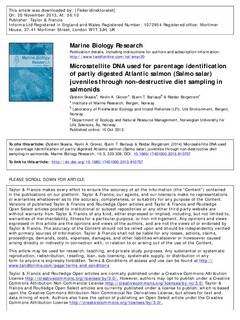| dc.contributor.author | Skaala, Øystein | |
| dc.contributor.author | Glover, Kevin A. | |
| dc.contributor.author | Barlaup, Bjørn T. | |
| dc.contributor.author | Borgstrøm, Reidar | |
| dc.date.accessioned | 2013-11-20T14:14:04Z | |
| dc.date.available | 2013-11-20T14:14:04Z | |
| dc.date.issued | 2013-10-15 | |
| dc.identifier.citation | Øystein Skaala, Kevin A. Glover, Bjørn T. Barlaup & Reidar Borgstrøm (2014) Microsatellite DNA used for parentage identification of partly digested Atlantic salmon (Salmo salar) juveniles through non-destructive diet sampling in salmonids, Marine Biology Research, 10:3, 323-328, DOI: 10.1080/17451000.2013.810757 | no_NO |
| dc.identifier.issn | 1745-1019 | |
| dc.identifier.issn | 1745-1000 | |
| dc.identifier.uri | http://hdl.handle.net/11250/109092 | |
| dc.description.abstract | Predation during early life history is an important component of fitness in salmonids. Farmed Atlantic salmon display lower survival in the wild in comparison to wild salmon; however, the underlying mechanisms remain unknown. Salmon eggs from 69 families of farmed, hybrid and wild parentage were planted into a river. Following swim-up, 760 brown trout predators were non-lethally sampled. Of the trout, 4.2% had ingested salmon fry (0-15 fry/trout). From a total of 48 salmon fry recovered from trout stomachs, 46 were successfully identified to family using microsatellites. Of the 69 planted families, 29 were represented among the predated salmon fry; however, there were no significant differences in susceptibility to predation between the three groups (farm, wild and crosses), but the power of resolution was low due to small sample sizes. Nevertheless, we have successfully demonstrated that microsatellites can be used to address natural selection via diet analysis of predators in a natural system. | no_NO |
| dc.language.iso | eng | no_NO |
| dc.publisher | Taylor & Francis | no_NO |
| dc.title | Microsatellite DNA used for parentage identification of partly digested Atlantic salmon (Salmo salar) juveniles through non-destructive diet sampling in salmonids | no_NO |
| dc.type | Journal article | no_NO |
| dc.type | Peer reviewed | no_NO |
| dc.subject.nsi | VDP::Agriculture and fishery disciplines: 900::Fisheries science: 920::Fish health: 923 | no_NO |
| dc.source.pagenumber | 323-328 | no_NO |
| dc.source.volume | 10 | no_NO |
| dc.source.journal | Marine Biology Research | no_NO |
| dc.source.issue | 3 | no_NO |
| dc.identifier.doi | 10.1080/17451000.2013.810757 | |
